
Solar Eclipses
by Jordin Lim & Milan Riley
A total solar eclipse is an astronomical wonder that most people have the opportunity of seeing only a few times during their lives. This rarity makes the experience of witnessing one so much more incredible, and many people will travel great distances to see a total eclipse in its full splendor. Despite these globally renowned events, many people don’t really know the cause behind them. Why does a solar eclipse happen?
Explanation for a Solar Eclipse
A solar eclipse is an event in which the Moon passes between the Sun and the Earth, thereby partially or fully blocking the Sun’s light and casting a shadow on Earth in some areas.
With this knowledge in mind, you might think: why don’t solar eclipses occur more often? Doesn’t this alignment of the Sun, Moon, and Earth happen frequently? Solar eclipses are rare because the Moon’s orbit is tilted 5 degrees to Earth’s orbit around the Sun. This tilt means that the Moon often passes above or below the Earth, missing that perfect alignment and therefore not creating a solar eclipse. That’s why we don’t get to see our beloved solar eclipses more often. So the next time you hear of an upcoming solar eclipse, make sure you mark your calendars and run to get some solar eclipse glasses!
Types of Solar Eclipses
Did you know there are three types of solar eclipses?
- Total Solar Eclipse: A total solar eclipse is only visible to a small part of the Earth. Those who see a total solar eclipse are located in what’s called the “path of totality” in the the center of the Moon’s shadow when it hits Earth. In order for this to occur, the Sun, Earth, and Moon must be in a direct line.
- Partial Solar Eclipse: A partial solar eclipse occurs when the Sun, Moon, and Earth are not directly in line and the Sun is not completely covered. The Sun seems to only have a dark shadow on a small part of its surface. This is the type of eclipse that occurs most frequently.
- Annular Solar Eclipse: An annular solar eclipse occurs when the Sun, Moon, and Earth fall in line, but the Moon is farthest away from the Earth in its orbit. The Sun is not completely blocked off and there appears to be a ring encompassing the Moon.
Fun fact: A phenomenon known as a “diamond ring” occurs during a total solar eclipse right before the Sun is completely covered by the Moon. During this, a little bit of the Sun peeks out, making this sensation look like a diamond ring!

Lunar Eclipse
Another eclipse you may have heard of is a lunar eclipse, which (as you might be able to infer based on the name) has to do with shadows being cast on the Moon! During a lunar eclipse, the Moon moves into the Earth’s shadow, causing the Moon to be darkened. The lunar surface becomes a striking red over the course of a few hours. Lunar eclipses are visible from half of the Earth.
Fun fact: Despite contrary belief, lunar eclipses are not more common than solar eclipses; they actually occur in equal numbers!

How Can You View A Solar Eclipse?
Solar eclipse eye safety is extremely important, so it’s important that you are armed with the correct eye protection to watch the eclipse since permanent damage to your corneas can occur very quickly. Solar eclipse glasses are specially designed to keep your eyes safe while you watch the eclipse.
Test your glasses: A strong sign that your glasses are good to keep your eyes safe is that when you put them on in normal room fighting, all you see is black. Even if your glasses pass this test, make sure you’ve bought your glasses from a reliable supplier.
The Most Recent Solar Eclipse
It’s doubtful that anyone could miss it, but a few weeks ago on April 8, 2024, Earth experienced a total solar eclipse. Officially named the Great North American Eclipse, its totality was visible from many parts of North America, including Mexico, Canada, and the United States. Many of us watched from campus using specialized glasses. In addition, it was considered an unusually long eclipse, with totality lasting 4 minutes and 28 seconds. Here are a few photos of the event:

These pictures show the flight path and eclipse progression:

Is it a Conspiracy?
While scientists have studied the astronomy behind eclipses for years, others have made their own theories. Ideas about eclipses span from it causing the plague to it harming pregnancies. One myth is eclipses are a government scheme to encourage consumers to buy eclipse glasses. But as with anything you read on the internet, make sure you fact check that what you’re reading is true. You wouldn’t want to miss a beautiful eclipse because of it!
Watch out for the next total solar eclipse to occur in North America, which will happen in 20 years on August 23, 2044! However, if you can’t wait that long, there is an total eclipse coming August 12, 2026, visible from Russia, Greenland, Iceland and Spain. Here’s the worldwide schedule for the next decade: https://www.space.com/next-10-years-solar-eclipses-2026-to-2034
Read More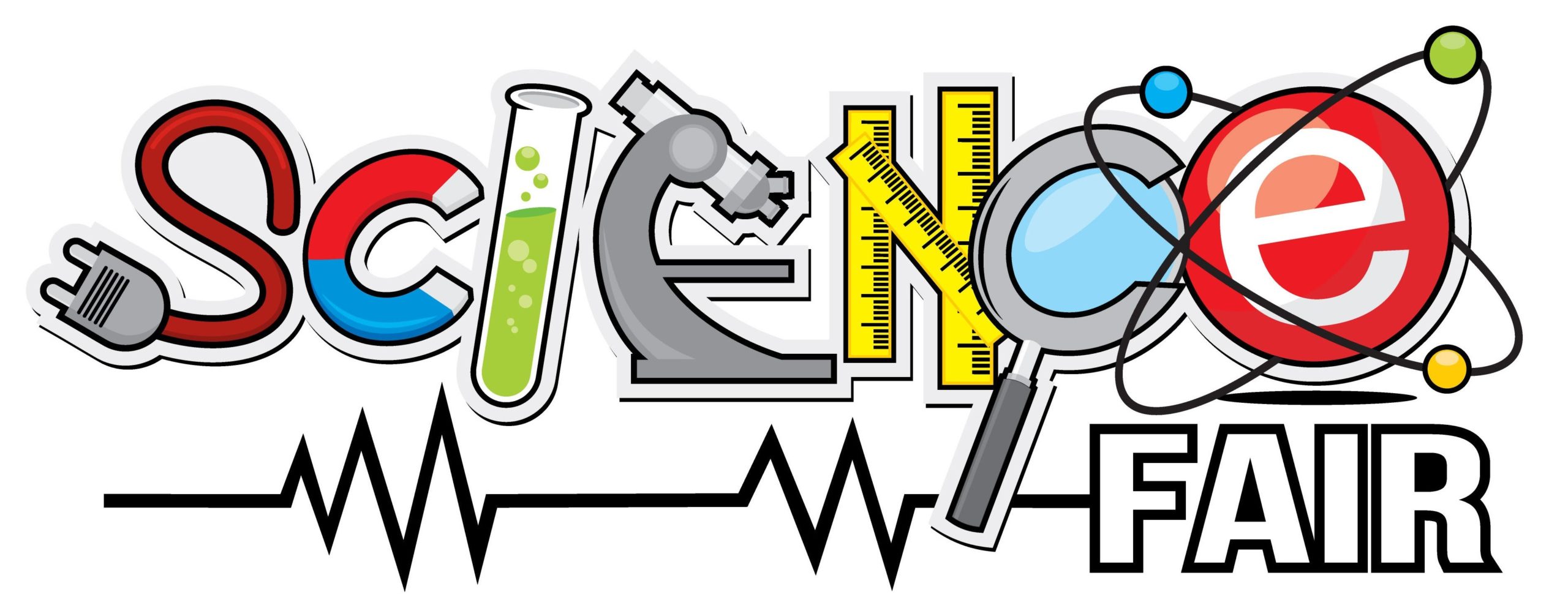
8th Grade Science Fair Interviews
by Andi Villamor
Congratulations to all the 8th Grade Winners!
-
1st Place: Ione McLain (How Does Air Quality…?)
-
2nd Place: Evan Goodman and Simon Oshev (Chill Pill)
-
2nd Place: Max Pestes and Isaac Sapire (Removing Microplastics from Water)
-
3rd Place: Collin Lee and Roy Li (The Wind Turbine Showdown)
-
Honorable Mention: Margaux Lane (Measuring the Strength of I-beam Types)
-
Honorable Mention: Hasmik Yedoyan and Tanvi Chandrashekhar (The Effect of Saturation on the Perception of the Image)
Simon Oshev and Evan Goodman (2nd place winners)
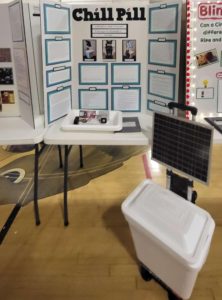 What is the title of your project? Chill Pill
What is the title of your project? Chill Pill
What was your project about? It’s a solar-powered solution for medication storage for the unhoused.
Why did you choose this project? We saw that homelessness is a big problem in Los Angeles, and I take allergy medication, so it made me think about how the unhoused are unable to store medication if they have allergies like me or other health issues.
What did you use to make the storage system? We used a thermoelectric module, which uses two different types of semiconductors to cool one side of the device and heat the other side, and we added heat sinks and fans to carry the cool air out.
How did you determine your design for the storage? We looked at [factors like] portability, low cost, and simplicity.
What was the biggest challenge you faced? It was kind of the team aspect, like finding the right times [to work on the project together].
If you did this project again, what would you do differently? The problem is the efficiency. Basically, after one hour, the temperature goes down to about 50 degrees and it shuts off because we set the battery so that there’s a discharge limit to make it safer. So in order to fix that, we would have to add a temperature-sensing circuit breaker so that when it gets cool enough, it turns off, and once it gets hot enough, it turns back on.
What would be the next steps for the project if you wanted to partner with an organization and implement it on a larger scale? Make it more user-friendly because it’s kind of difficult to learn how to use it. [We would also make it] sturdier and more durable. By sturdier, I mean safer to the elements, like making it waterproof.

Margaux Lane (Honorable mention)
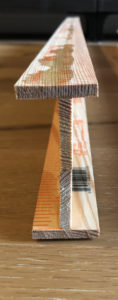 What was the title of your project? Measuring the Strength of Different I-Beams
What was the title of your project? Measuring the Strength of Different I-Beams
What was your hypothesis? The beam that is thickest in the middle would be the strongest, and it was. [If a beam has a greater thickness in the middle, then it will have a lower distance displacement after the addition of weights].
How did you do the experiment? I used yard sticks and wood glue, and I made these long wooden beams [of different thicknesses] and put weights on the ends to see how much they would bend. [To measure that,] I clamped one end of the beam to a table and I measured its distance to the ground before I put the weight on it and then I put the weight on and measured that distance, then calculated the displacement – so the ones with the least displacement [bent the least and were therefore] the strongest.
Why did you choose this project? I chose it because I thought it would be interesting to see which models would be the strongest.
What application do you think your project could have? The project could be applied to construction and creating stronger infrastructure.
What was the biggest challenge you faced? The biggest challenge was probably while I was testing it, just getting the measurements accurate and making sure they were bending the right way. Some of them broke at the end.
If you did this project again, what would you do differently? I would probably make [the beams] stronger and test them with more weights.

Tanvi Chandrashekar & Hasmik Yedoyan (Honorable mention)
 What was the title of your project? How Does Saturation Affect the Perception of an Image?
What was the title of your project? How Does Saturation Affect the Perception of an Image?
What was your hypothesis? If the saturation of an image is between 50-75 chroma level, then people will gravitate towards it more.
How did you do the experiment? We got eighty people to take a survey with thirty images, and each of them were saturated to a different level. They then [rated] which images they liked the most and we analyzed the data with graphs and came to the conclusion that people like images with a chroma level of 50-75.
Why do you think this level of saturation is the most appealing? It makes the pictures more vibrant so that they’re more attention-grabbing, but not so vibrant that it makes them look less natural.
 Why did you choose this project? We wanted to do something color-related, and apparently doing color was really hard because we had to learn about the color scale [and other aspects of color theory], so we just chose saturation.
Why did you choose this project? We wanted to do something color-related, and apparently doing color was really hard because we had to learn about the color scale [and other aspects of color theory], so we just chose saturation.
What was the biggest challenge you faced? Mainly just trying to analyze the graphs since there was so much data.
If you could do this project again, what would you do differently? We would do a smaller test group, because eighty was a lot, and it was really hard.

Congratulations also to the High School Winners!
-
Naira Badalyan (9th) (Using Microchannel Heat Sinks to Enhance Cooling of Solar Cells and Increase Power Output)
-
Ryan Lee (10th) (Modeling the Atlantic Maritime Trade with Physarum Polycephalum Slime Molds)
-
Geonhee Lee (10th) & Harshini Manikandan (10th) (How does the Aspect Ratio of the Wing of the Aircraft Correspond to the Lift and Drag Ratio)
-
Valeri Petrosyan (9th) (The Simulation and Use of Reinforcement Learning AI for Path Generation of Target-Seeking Munition)
-
Xavier Rowe (10th) (Testing the Methane Yield of Different Food Groups)
7th Grade Science Fair Interviews
by Maleeya Mickelson
After months of diligently working on their projects, from researching to experimenting to painstakingly assembling their boards, our 7th and 8th grade students have finally been able to showcase their hard work at the annual Science Academy Science Fair. This year saw many informative projects from the students aiming to solve a variety of problems with a creative approach. Congratulations to the following 7th grade students who won this year’s school Science Fair and who will be advancing on to the Los Angeles County Science Fair where they’ll represent The Science Academy STEM Magnet:
1st Place – Aiden Kim & Jayden Park
2nd Place – Jackson Rutner
3rd Place – Adam Young
Honorable Mention – Daniel Jang
I interviewed the 1st place winners, Aiden Kim and Jayden Park, and the 2nd place winner, Jackson Rutner, to learn more about their projects and their overall reflection on this year’s experience.
1st Place – Aiden Kim & Jayden Park | “What is an MFC?”
 What was your hypothesis?
What was your hypothesis?
If bacteria in soil were to generate electricity with a microbial fuel cell (MFC), then it would generate more electricity than distilled water that has no bacteria to use and be able to power a microbial fuel cell.
What information was your project aiming to find out?
We were trying to find out if bacteria can generate electricity using a MFC or an alternative battery that collects energy by taking the electrons from biochemical reactions catalyzed by bacteria. We also were trying to find out if an MFC utilizing bacteria generates more electricity than an MFC using distilled water.
How did you conduct your experiment?
Our experiment utilized the power of electrogenic bacteria, such as E. coli, which are special types of microbes. Due to electrogenic bacteria being able to release electrons extracellularly, anodes in a MFC are able to take the electrons and harness them to electricity. Many of these types of electrogenic bacteria important to MFCs are commonly found in all types of soils. The overall set-up of our experiment consisted of two sets of two large containers connected by two small pipes. In one set, we put soil and bacteria food into one container and normal tap water with an oxygen generator in the other. The other set of containers was set up the same way, but instead of soil, we used distilled water and didn’t add any bacterial food because it is not needed for the distilled water. Once this was built, we used a volt multimeter to measure the amount of millivolts three times a day.
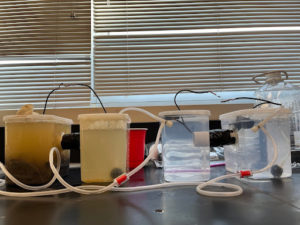 How did you overcome complications during the experimental process?
How did you overcome complications during the experimental process?
A complication we ran into was that the pipe connecting the two containers for our experiment was slowly leaking, potentially changing the amount of electricity generated. So, the real amount of electricity generated may be higher than our observation.
What were the results of your experiments?
Our results showed that the bacteria with MFC generated more electricity than distilled water with MFC, which supported our hypothesis. In our experiment, electricity was produced by the soil bacteria MFC, at an average of 5.04 mV. In the distilled water MFC, the amount of voltage generated remained roughly about 0 mV. In the soil MFC, the voltage pattern was increased and peaked at day 7, and the amount of voltage was then dropped. The reason behind the amount of voltage being reduced might have been that the food ran out, or the bacteria died/stopped growing.
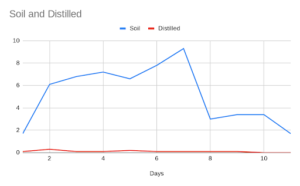
What inspired you to choose this topic for your project?
We were scrolling on TikTok and found an interesting video about bacteria creating electricity, which led us to creating our project. The outcome of our experiment could be helpful to people in the future because MFCs could lead to a more efficient production of electricity.
If you were to do this project again (or one similar), what would you change?
If we were to do this project again, we would have tried to make a permanent MFC by adding bacteria food every week and seeing if the bacteria survives, or we would make our MFC generate more volts as our current MFC can only generate a couple millivolts.
What advice do you have for those participating in the science fair next year?
Always try your best and be your best at all times.
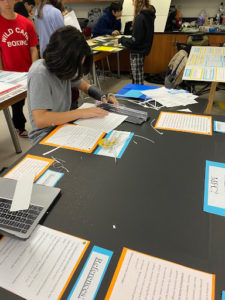
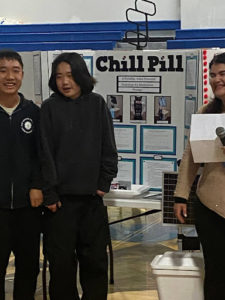
2nd Place – Jackson Rutner | “Tidal Trouble: How Does Different Tidal Patterns Affect Erosion?”
 What was your hypothesis?
What was your hypothesis?
If different tidal patterns are compared to each other, then semidiurnal tides (a type of tidal pattern that cycles twice a day instead of once a day like diurnal tides) will cause the most erosion compared to diurnal tides because of a faster tidal pattern.
What information was your project aiming to find out?
I was trying to figure out how erosion in different places with different tidal patterns affect how fast the land loses mass.
How did you conduct your experiment?
My project uses a tank, chalk and a VEX v5 system. To prepare I code the VEX v5 system to have the motor move the styrofoam with a custom function to simulate diurnal tides. Afterwards, I put a block of chalk into one edge of the tank. To set up the system, I suspend the styrofoam with the metal plates at the bottom 0.5 inches below the top of the chalk. I fill the tank to the top of the chalk block with water. Now I run the program for two weeks or until the chalk is gone. To record my data, I weigh it by the end of the 2 weeks. For semidiurnal tides, I repeat the process with a custom function to simulate the semidiurnal tides. Finally, I repeat with no function for the control.

How did you overcome complications during the experimental process?
A complication I ran into was having a way to simulate the tides was tough and I even cracked the first tank I was going to use because of a faulty design to control the water level. To fix that problem I used rubber bumpers to hold tightly but not destroy the tank like I did in the previous iteration.
What were the results of your experiments?
According to the data collected, the hypothesis that if tides are compared to each other, semidiurnal tides will cause the most erosion compared to diurnal tides because of a faster tidal pattern appears to be incorrect. It would appear that the slower diurnal tides were able to have more impact because the surface of the water could be affected. The tides do seem too small to play a significant role in the grand scheme of things of the ocean. The project did have some errors, like the fact that it was not one solid eroded block. Also because the chalk absorbed water, it gained 10 ounces, changing the experiment.

What inspired you to choose this topic for your project?
I had a question in sixth grade in science class that Mr. Lewis did not know the answer to, and I could not just google it, so I decided I may as well have a science project that I was actually interested in so I would not put in lackluster effort to make sure that the project was enjoyable and relevant.
If you were to do this project again (or one similar), what would you change?
If I did this project again, I would make sure that the simulation had a greater effect on the water level because the styrofoam I used to control the water level was not thick enough to move the water the amount that I had hoped for in this experiment.
What advice do you have for those participating in the science fair next year?
Make sure that you like your project and have a unique and novel project – be sure you can’t just Google search the project type or the answer.


Pictures of Science Fair and Board Assemblies:
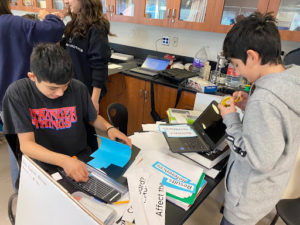


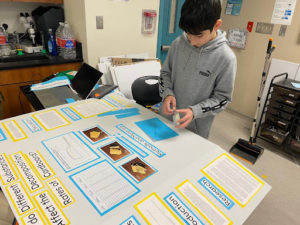

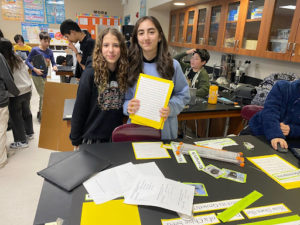

Artificial Intelligence
by Anaelle Tadros
Artificial intelligence isn’t a new concept; in fact, in 1956, John McCarthy coined the term at Dartmouth College. However, the topic of AI has become more common and has been popping up in a lot of conversations recently. There have been lots of questions about whether or not AI is beneficial for our society, or if it’s going to ruin and deteriorate the community. It has been especially controversial in terms of its uses in education. Lots of AIs are ones we are familiar with, like Apple’s Siri,  Amazon’s Alexa, and Microsoft’s Cortana. Some other systems use AI too, like Tesla and the latest models from BMW. The car companies use AI algorithms for their self-driving models. Other situations where AI is used are in content creation in marketing, advertising, and movies.
Amazon’s Alexa, and Microsoft’s Cortana. Some other systems use AI too, like Tesla and the latest models from BMW. The car companies use AI algorithms for their self-driving models. Other situations where AI is used are in content creation in marketing, advertising, and movies.
Recently, it’s also been used to help with natural disasters. California’s main firefighting agency is using AI to find visual signs of wildfires. They’re using over a thousand high definition cameras to locate where fires are happening and determine how fast they are spreading. When signs are apparent, the AI models send alerts to the state’s fire department control center to prevent the fires from spreading. The only issue is that human confirmation is required to make sure that these alerts are true and not just false alarms. According to ArsTechnica.com, this has been a problem, with the alerts being frequently set off by fog or by steam from geothermal plants. Setting up these systems also takes a lot of time and effort, and could therefore take away resources and focus from other important emergency initiatives.
AI has a bit of a negative connotation, with many people worried it may soon be able to take over the world. However, our school has used it for a lot of great projects, such as informational posters in the hallways, and many are hoping to incorporate it into our learning environment even more. Because AI is guaranteed to be a part of our generation’s future, our school held a meeting on November 13th to discuss ways our school district could better incorporate AI in the classroom. During this meeting, several people discussed how they use various AI software, while others explained how they use AI in appropriate ways for their own artwork and in drafting college essays. One person used AI for help in compiling their resume and another proposed the idea of using AI to make team shirt designs.
 In this meeting, problems from AI were also discussed, with some mentioning that the suitability of AI’s usage really depends on the person using it. AI can be thought of as a harmful resource because lots of individuals use it to cheat and plagiarize. However, if given to the right person, they will use it as a way to improve their work and learn more deeply. For example, one person may use AI to write an essay, giving them either no benefit in learning how to write effectively themselves or giving them an unfair advantage in the system, while another person may use AI responisibly to give their essay more polish, maybe using it to find stronger phrasing or correct grammar mistakes. A student mentioned using AI to ask questions about a topic they were unclear on from their science class, thus showing how AI allowed them to deepen their understanding. Speaking of cheating, AI is also useful in finding instances of plagiarism. Applications like Turn It In and Grammarly have AI softwares that are used to make sure students aren’t just copying and pasting another person’s work.
In this meeting, problems from AI were also discussed, with some mentioning that the suitability of AI’s usage really depends on the person using it. AI can be thought of as a harmful resource because lots of individuals use it to cheat and plagiarize. However, if given to the right person, they will use it as a way to improve their work and learn more deeply. For example, one person may use AI to write an essay, giving them either no benefit in learning how to write effectively themselves or giving them an unfair advantage in the system, while another person may use AI responisibly to give their essay more polish, maybe using it to find stronger phrasing or correct grammar mistakes. A student mentioned using AI to ask questions about a topic they were unclear on from their science class, thus showing how AI allowed them to deepen their understanding. Speaking of cheating, AI is also useful in finding instances of plagiarism. Applications like Turn It In and Grammarly have AI softwares that are used to make sure students aren’t just copying and pasting another person’s work.
Recently, Principal Mr. Lauchu, Asst. Principal Mr. Rosenthal, Computer Science teacher Mr. Bradfield, and SciFi parent and STEM adviser Mr. Tsao sat down together to discuss the implications of artificial intelligence in the classroom, and LAUSD has released their discussion as a podcast.
Listen here: https://www.lausd.org/Page/16535

To prove the point that AI is quickly being incorporated into so many settings, I used ChatGPT for the first time in my life to write this concluding paragraph:
In conclusion, the advent of artificial intelligence has ushered in a transformative era, reshaping the landscape of industries, society, and human interaction. As AI continues to evolve, its potential for innovation and efficiency is undeniable, offering solutions to complex problems and unlocking new possibilities. However, the ethical implications and potential risks associated with AI demand careful consideration and responsible development. Striking a balance between harnessing the benefits of AI and safeguarding against its potential pitfalls is crucial for a sustainable and inclusive future.
If you have ideas about how AI can help improve our learning, don’t be afraid to share them with our teachers and administators!
Sources:
- What is Artificial Intelligence in 2024? Types, Trends, and Future of it?
- What is Artificial Intelligence (AI) ? | IBM
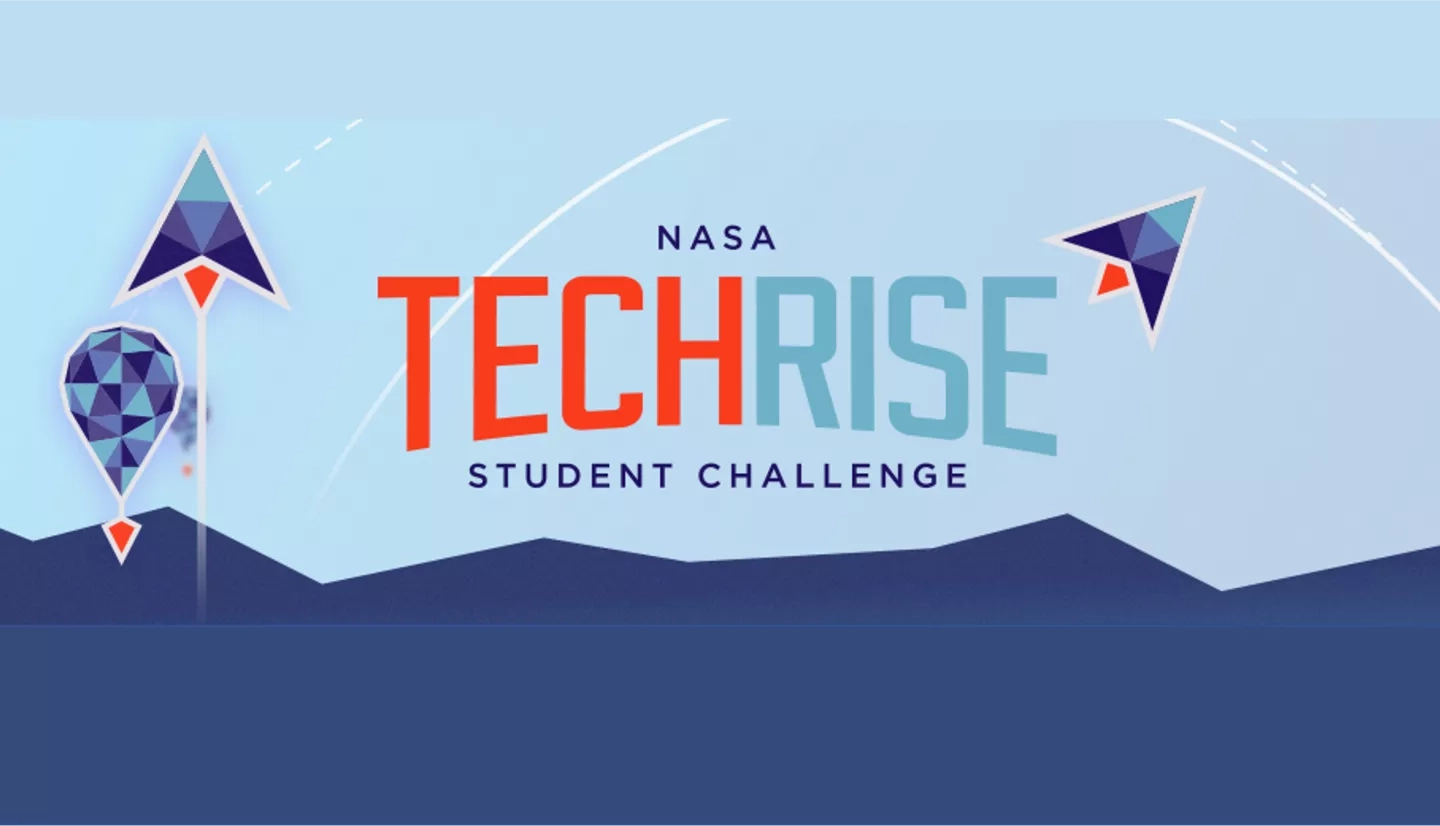
NASA TechRise Challenge
by Ryan Kim
Have you ever wanted to conduct an experiment in a space-like atmosphere or design an experiment for NASA? In the new 2024 TechRise Student Challenge, you can do exactly that. Interested students can join any time before October 20. Those in the Robotics or StellarXplorers clubs may be especially interested.
NASA has invited all schools with students in grades 6-12 to form a group to design, build, and submit an experiment to be held in a high-altitude balloon or rocket-powered lander in the 2024 TechRise Student Challenge. Students can participate in the challenge by going to https://www.futureengineers.org/nasatechrise, and submitting their proposals.
How To Participate
To participate in the challenge, students must first form a team of four students and a team leader (a teacher or school employee). The team can consist of four students spanning from grades 6-12 with no limit of students per team. Secondly, students must read the proposal template and guide at https://tinyurl.com/mru394z2. Next, choose between a rocket-powered lander or a high-altitude balloon for your experiment. The rocket-powered lander includes a clear view out to the ground from eighty feet, or about as high as a six-story building. The flight time for your experiment will be about two minutes. From the balloon, your experiment will be open to the air with the ability to take pictures vertically and horizontally. It will ascend through the troposphere and into the stratosphere from Baltic, South Dakota while attached to a frame called a gondola. Once it reaches 70,000 feet, the balloon will stay there for at least four hours. After the experiments have been concluded, the balloon will separate from the gondola and fall to the ground where NASA will retrieve the experiments.
 Example of the gondola.
Example of the gondola.
Your team leader can submit the proposal on or before October 20, 2023, and the winners will be announced on January 16, 2024, with a prize package of $1,500 for their experiment, a flight box, technical support for the experiment, and an assigned spot for the experiment. The experiments must be mailed no later than May 10, 2024. The experiments will be launched in the summer of 2024.
 A NASA experiment being launched.
A NASA experiment being launched.
NASA said that the goal of the challenge is to inspire “a deeper understanding of space exploration, Earth observation, coding, electronics, and the value of test data.” All students are encouraged to apply and participate in the challenge, so be sure to send your experiment ideas to TechRise! For more information go to: https://www.futureengineers.org/nasatechrise and https://www.youtube.com/watch?v=aNSdAIDS9lI.
Read More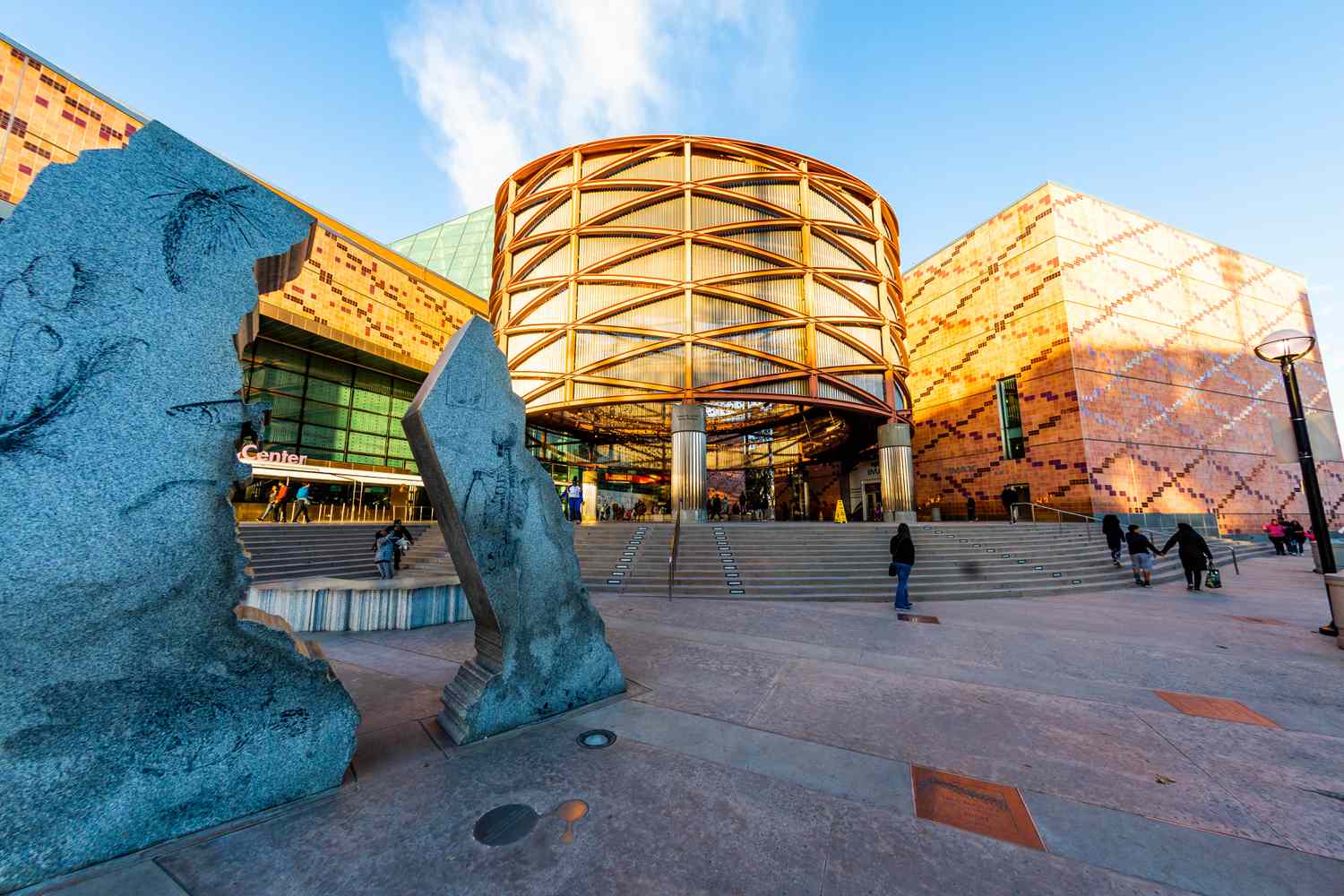
Fall 2023 Middle School Science Center Field Trip
by Maleeya Mickelson
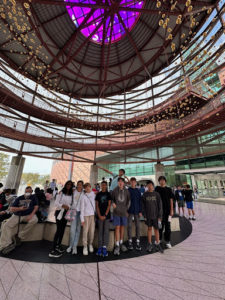 A favorite Back to School tradition is our annual middle school field trip to the California Science Center, which this year took place on September 21, 2023. This field trip occurs early on in the school year, giving students a great opportunity to make new friends, socialize, and share some science-related adventures.
A favorite Back to School tradition is our annual middle school field trip to the California Science Center, which this year took place on September 21, 2023. This field trip occurs early on in the school year, giving students a great opportunity to make new friends, socialize, and share some science-related adventures.
The California Science Center was created to teach students about science in a fun way using hands-on exhibits. At the Science Center, studentsare able to further their knowledge on subjects they’ve been learning about at school as well as general scientific topics of interest. As a STEM school, it’s especially important that we go field trips like this in order to allow students to use their critical thinking and creativity to learn more about different scientific concepts. This field trip can also spark new scientific interests that students may want to explore in the future.
Right after we arrived at the Science Center, we watched the IMAX movie Blue Whales. IMAX movies are different from regular movies, in that they are shown on gigantic screens and in 3D. The IMAX movie we watched this year showcased the journeys of two crews of scientists: one documenting whales in the Gulf of California, and the other searching for a missing population of blue whales off the Seychelles Islands. This movie taught the students about the communication methods, diets, survival challenges, and so much more regarding these massive creatures, which are the largest mammals to ever live on Earth. Most importantly, the students learned about the impact of blue whales on the oceans’ ecosystems and why we must strive to protect them.
Once the IMAX movie finished, everyone headed to the cafeteria area to eat lunch. After lunch, groups of students with their chaperones were free to head off to explore the exhibits.
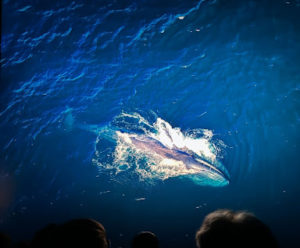
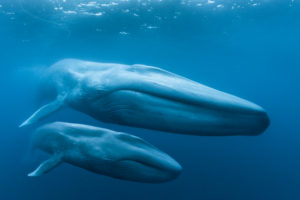

Images from Blue Whales
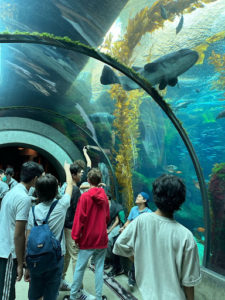 The California Science Center includes four major exhibit areas: World of Life, Creative World, Ecosystems, and Air and Space. The World of Life exhibit highlights aspects of human biology, evolution, and genetics to teach students more about the living world around them and how it came to be. Creative World shows students how people take advantage of technology to help them with transportation, communication, and construction projects. The Ecosystems exhibit lets students explore more that 200 species of plants and animals in various environments. This exhibit shows how organisms on Earth all depend upon each other and are therefore interconnected. The Air and Space section of the Science Center allows students to learn more about atmospheric flight and space travel using the principles of science and engineering. This exhibit area also houses the space shuttle Endeavour, which will unfortunately be leaving the Science Center on December 31, 2023 until its new exhibit is created nearby at the future Samuel Oschin Air and Space Center.
The California Science Center includes four major exhibit areas: World of Life, Creative World, Ecosystems, and Air and Space. The World of Life exhibit highlights aspects of human biology, evolution, and genetics to teach students more about the living world around them and how it came to be. Creative World shows students how people take advantage of technology to help them with transportation, communication, and construction projects. The Ecosystems exhibit lets students explore more that 200 species of plants and animals in various environments. This exhibit shows how organisms on Earth all depend upon each other and are therefore interconnected. The Air and Space section of the Science Center allows students to learn more about atmospheric flight and space travel using the principles of science and engineering. This exhibit area also houses the space shuttle Endeavour, which will unfortunately be leaving the Science Center on December 31, 2023 until its new exhibit is created nearby at the future Samuel Oschin Air and Space Center.

The different exhibits with many interactive and informative experiences help to make the annual middle school field trip to the California Science Center a great way for the students at The Science Academy to learn more about science while also having fun. The hands-on exhibits and IMAX movie covered a handful of scientific topics including aquatic mammal biology, human biology, evolution, genetics, engineering, architecture, environmental and climate challenges, atmospheric flight, and space travel. Overall, this field trip gave the middle schoolers a very fun, engaging, and educational experience made possible thanks to our students and their families through donations to the Science Academy Fundraising Initiative (SciFi), which paid for the IMAX admissions and bus transportation. Thank you, SciFi!
More pictures:



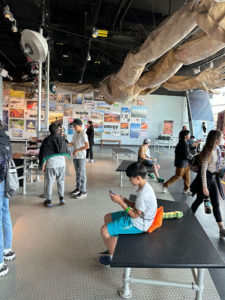
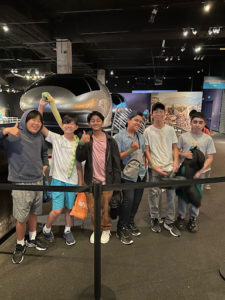


8th Grade Science Fair Interviews
by Ryan Park
For Science Academy’s 2022-2023 Science Fair, I interviewed two 8th graders to learn more about their projects: Dani Tsao, 1st place winner, and Aspen Chung, 2nd place winner.
* Dani Tsao’s Science Fair project built on her experiment from last year in creating a new type of solar panel.
What inspired you to choose your Science Fair topic?
My experiment this year is a continuation of last year’s project. I first thought of my idea when I was driving around my neighborhood and realized that there are mainly two types of solar panels: a) those that create electricity, and b) those that heat up water. When I saw this, I thought “Why can’t there be a solar panel to do both?”
What experiment did you do? What were your hypothesis and results?
With the above question in mind, I combined an electricity-generating and a water-heating solar system. Although the solar panel efficiency increased, I have thought of another idea for further improvement.
This year, I decided to make a control system that rotates the solar panel so that it always faces the sun. My results showed that this new solar panel design, combined with improved thermal insulation, increased the electricity-generating efficiency as well as heated up the water more. Compared to the original solar panel idea, this new design increased the energy capture efficiency by 25 – 30%.
Is there anything you’d like to say about receiving 1st place in your grade level?
I am very appreciative of this project because it allowed me to use the information I learned in Mr. Bradfield’s class about Arduinos and soldering. The award gives me a lot of satisfaction, but I think there are still more problems to be solved.
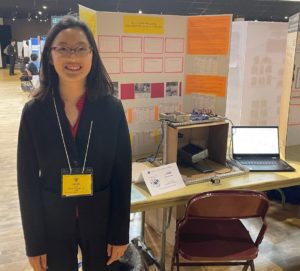
Dani at the L.A. County Science Fair
______________________________________________________________________________________________________
* Aspen Chung’s Science Fair project was about the growing danger of climate change and her method of using cleaner alternatives to carbon fossil fuels.
What inspired you to choose your Science Fair topic?
Our world is powered by fuel, ranging from transportation to heating to factories that produce many of the goods used in our daily lives. However, many of the non-green fuels that are commonly used contribute to climate change through carbon dioxide emissions, a greenhouse gas that is damaging our ozone layer. And in a world that is aiming to become greener, I believe it’s important to explore cleaner alternatives for fuel, such as hydrogen gas, which only emits water vapor as a byproduct.
What experiment did you do? What were your hypothesis and results?
My project focuses on finding the most effective way to produce hydrogen gas, which acts as a clean fuel source, through electrolysis. I varied the amounts of magnesium sulfate between 20 grams, 45 grams, and 75 grams to test how it affected the rate of electrolysis and the change in pH. I hypothesized that if the water has more magnesium sulfate, then the rate of electrolysis will be faster and the pH will change quickly. My hypothesis was proven correct through my experiment, where 75 grams of magnesium sulfate produced the fastest-changing pH, demonstrating a more efficient rate of electrolysis.

Aspen’s Science Fair Board
Read More7th Grade Science Fair Interviews
by Liz Zarikyan
This year’s Science Fair, which took place February 6-8th, was a showcase of projects from 7th and 8th grade students that uncovered mysteries, revealed solutions to some of our world problems, and even provided resources to use in case of emergency. I interviewed some of the 7th grade winners to find out more about their projects.
Jordan R. – Honorable Mention – 7th grade
What was the title of your project? 
The Effects of Proteinase K on the Biodegradation of Plastic
Why did you choose to do this project?
I was interested in finding a way to safely degrade plastic because I’ve seen plastic pollution and have wondered how that problem could be solved. Only around 9 percent of plastic is recycled so I started my research to see if there was any way to eliminate it. I thought this method was a good option for dealing with the problem, and Proteinase K got my attention due to its ability to degrade the polymers in plastic. The surrounding soil is used through the existing microbes that consume the lactic acids which are created when the polymer is broken down by the enzyme.
Did you have any complications when working on your project?
It was hard to find proteinase K, which is an enzyme used in molecular biology. It was hard to find because it’s not an item that’s bought on a day-to-day basis, making it less available. I didn’t consider purchasing other enzymes because I researched other “digestive” enzymes such as lipase and I found that they would not be effective on plastic. I originally tried to obtain the enzyme from BLIRT, which is the primary European manufacturer of recombinant enzymes, but after applying for an offer and not getting a response, I searched for other suppliers and was then able to purchase it on eBay.


What was your process?
I tested the effects of the enzyme on the plastic by embedding the different amounts (0 mg, 10 mg, 40 mg) into 50 g of soil and then using that to cover plastic disks that came from disposable food containers. After 2 weeks of putting these out in the sun, I used Image J, which is a Java-based image processing program that provides the function of calculating the surface area within an image.
What were your results?
Proteinase K helps biodegrade plastic by a decent amount. 40 mg of Proteinase K was able to lower the surface area of plastic by over 8% in just 2 weeks.
If you could do this experiment again, what would you change?
I would run more trials because I want to test out increasing the amount of enzyme and/or composting time period.
What was the best part of your experiment?
The best part of the experiment was seeing how the plastic had degraded. I was interested to see how the experiment would turn out and was happy that it worked.
Paria V. & Kayla A. – tied for 1st place – 7th grade

What was the title of your project?
“Water on the Go: Creating an Emergency Water Filter”
Why did you choose to do this project?
We set out to create a water filter that could be used while hiking with available water, so we wanted to find out how much cleaner you can make dirty water through a mechanical process. Also, there is a shortage of clean water around the world due to natural disasters and human-orientated events, and this process could possibly allow for places around the world to have drinkable water.
What were your results?
We measured our results using a TDS meter. The TDS meter measures parts per million (PPM) of dissolved sediments in a substance. In our first trial, we had a starting PPM of 311 and a resulting PPM of 273. In our second trial, the starting PPM was 357, and it resulted as a PPM of 303. In our third trial, we started with a very high PPM of 493, which is close to the highest contaminant level and highly dangerous to consume. The resulting PPM was 343, which was a very significant change. It brought water with an almost max contaminant level down to the same PPM as tap water.
What was the best part of your experiment?
The best part was testing each layer before putting it in the filter to see how it would filter dirty water on its own. The layers we used were two pieces of foam on each end, then a starting layer of charcoal, then sand, then small rocks, and lastly, a final layer of charcoal. These layers were separated by a small layer of straining fabric so they wouldn’t mix. We decided to add another layer of charcoal, because we found that it was the best filtering factor. Something interesting we found was that when you pour water onto activated charcoal, at first it will sizzle and bubble. Afterwards, the water started to run clear, showing that the charcoal did a lot of the work. The activated charcoal strips out the toxins and odors in the water. The sand and rocks removed the larger sediments before reaching the last layer of charcoal.
 What was the process after you figured out your layers?
What was the process after you figured out your layers?
We drilled a hole into the cap of a bottle and cut the bottom off. We then sealed a coupling into the drilled hole with waterproof silicon to ensure it wouldn’t leak. Next, we attached tubing from the coupling to the main filter and in the middle placed a valve. The valve starts and stops the water flow. This part of the mechanism does not affect the results of the filter, but it does make the filter easier to use.
Did you have any complications when working on your project?
It was hard to drill a hole in the bottle cap, and it was hard to get the cloth pieces in the tube. We also had an unexpected trial when testing our filter when the PPM actually increased, meaning the water got dirtier. This was a result of us not compressing the layer enough, so the sediments got stuck in between the layers.
If you could do this experiment again, what would you change?
To improve our project we could add either a solar panel pump or a hand pump. This is because our filter was a bit slow because of the many thick layers. This would pump in the water, making it faster and more convenient. A hand pump would be added in case a large amount of clean water is needed in a short amount of time. We could also add a stand because it took two hands to hold the filter. If a stand is added, then the filter would be completely automatic and convenient. These add-ons are not necessary for the filter to work in case of an emergency, but they would be very helpful.


Final filtration process

Illustration of how solar power could be used to power water filtration on a larger scale
Read More
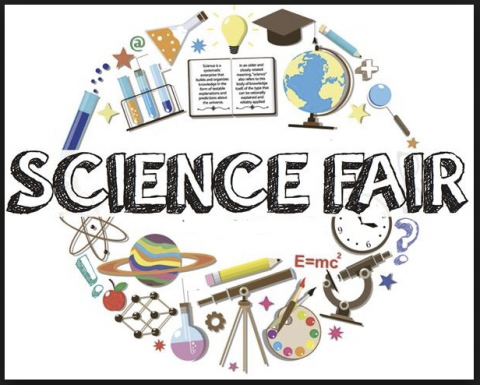
8th Grade Science Fair Winners
by Julia Shin
Congratulations to all of the Science Fair winners and good luck to all of the winners for County!
8th Grade
1st Place – Tanishga Thankaraj Vijay & Harshini Manikandan
Project Title: Determining Factors that Affect a Fan’s Performance

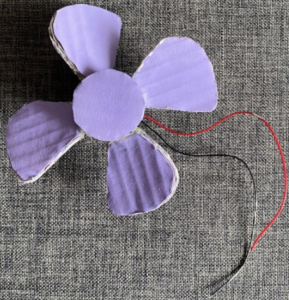
This fusion of an experiment and an engineering project was focused on determining which type of blade shape will generate the most voltage. Tanishga and Harshini created five common fan blades from cardboard and attached a bottle cap and a rod of a DC motor to the blades to complete the fan. Then, all of the five fans were positioned facing a house fan (maintaining equal distance and speed for each fan) as a multimeter measured the electricity generated. They discovered, the purple fan, as shown above, was the best design. As Tanishga and Harshini have an interest in the field of wind energy, they wanted to understand better how fans work, like the ones used in everyday life. From this project, they learned how the most important factors affecting a fan’s performance are the number of fan blades, the surface area, and the angle. Furthermore, they learned about the various fans and each of their unique purposes. Thus, they learned about the balance between having the least number of blades, however, not letting that comprise the loudness of the sound created by the fan or the fan’s effectiveness.
2nd Place – Jasper Mejia
Project Title: Solar Mini Fridge V2
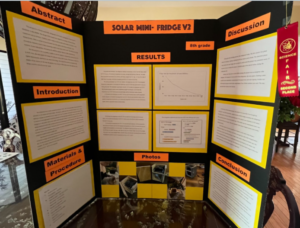
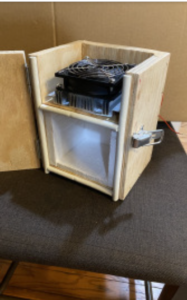
This engineering project was inspired by Jasper’s mom, who’s a Type 1 diabetic. Being a diabetic, she requires insulin to survive. Thus, for emergency purposes, when electricity may be unavailable, this solar-powered mini-fridge stores and cools insulin for insulin to be useable (for the fridge to be successful, it much reach a temperature between 34.0˚F – 40.0˚F). Also, since the fridge is solar-powered, it eliminates using multiple batteries just once. As Jasper shared, he believes this project could help people around the globe who have pre-existing conditions. From this project, he learned about various techniques of heat transfer and how to use different insulators to counter each of those methods. For example, he used wood, foam, and aluminum since they are all materials used to stop the heat. Additionally, he learned about how to have a polished final project, many prototypes have to be created and constantly revised.
3rd Place – William Kim
Project Title: Detecting Ink Levels With Image Processing

The purpose of this engineering project was to create an efficient and easy-to-use indicator that notifies the user how much ink is left inside a pen. Before using the pen, the ink level is determined and shown to the user so the ink container does not have to be removed (yet, this prototype mostly requires taking out the ink container to use it). William chose this project because he believed being able to view how much ink is left in a pen is very practical for daily life and it would help numerous people. From this project, he shared he learned that image processing can be very useful and that other future technological developments can solve other various common problems.
Honorable Mention – Iden Stein & Jamieson Wong
Project Title: The Odds of Cheating in Blackjack

The purpose of this experiment was to stimulate methods to count blackjack cards and discover how much money people collected from their bets. As Iden shared, he believed, “creating a blackjack simulation that card counts tens of millions of hands in minutes is absolutely awesome.” From this project, Iden and Jamieson learned that in simulations, there aren’t big differences in different card counting methods yet in real life, there are big differences.
Read More
The Perseverance Rover: A Personal Perspective
by Ryder Beeler
Touchdown! On February 18, 2021, the Perseverance Rover landed on Mars as millions of people watched the event all around the world. As I watched the landing, I was reminded of the time when I was seven years old. A friend of my parents, Ms. Jules Lee, worked for Jet Propulsion Laboratory (JPL) as a navigational engineer and she invited us to JPL for a visit and private tour. We saw the premises and even visited Mission Control, as well as what is known as the Clean Room. Engineers dressed in full body protective suits, caps, shoe coverings, gloves, and face masks that prevent even the smallest piece of dust or hair ruining sensitive instruments were working on a $2 billion spacecraft named Perseverance, which was set to launch some time in the next decade. And here we are: Perseverance got launched, successfully landed, and is already exploring Mars!
The Perseverance expedition has been widely covered in the news, but there are some aspects about Perseverance and Ingenuity that the public may not know about. I was honored to reconnect with our family’s friend, Jules Lee, who is one of the navigational engineers at JPL in Pasadena. I interviewed her and am very happy to be able to share some information with regards to the mission.

The main purpose of the mission is to see if there have been living organisms on the planet in the past or if they still exist in the present. Perseverance was stationed at Jezero Crater since it used to be a lake filled with water, which is required for life. It will take samples of the rocks in the ground, which will be stored in the rover until brought back to Earth. Once back, the samples will be tested for any water or remains of previously living organisms. Ingenuity will then be flying around the area surrounding the rover doing weather reports. Ingenuity is in its operations demo phase and is the first helicopter on Mars. Here is some further information from NASA on Ingenuity: https://www.nasa.gov/feature/jpl/6-things-to-know-about-nasas-ingenuity-mars-helicopter
As you now know, Perseverance and Ingenuity are the two main components of a rover program that were sent to Mars. However, did you know how Perseverance is linked to the next major mission or that the whole mission itself is much older than you think? Mrs. Lee stated that the Perseverance will play a major role in NASA’s next mission. The mission, which is not yet named, will be responsible for bringing the samples that Perseverance is currently collecting back to Earth. These samples will be used to determine if there was, or better yet now is, life on Mars. Perseverance didn’t just start in 2015 when it began to be built. The simple idea for the Perseverance was developed around the late 1990’s – early 2000’s. Approximately 15 years later, it had gained full attention from NASA and the build commenced. A little after that, the route for Perseverance was plotted, the spot of landing was chosen, and after the physical completion, multiple checks took place to ensure that the rover was in perfect condition.
In addition to some of the better known details, there are also some that do not receive as much coverage in the news: for instance, the fact that the United States wasn’t the only country involved in Perseverance. The mission was not just funded by and constructed solely here. Other space programs have contributed financial and material resources to the program where NASA / JPL would trade items and materials with space programs abroad, like Centro de Astrobiologia  Instituto Nacional de Tecnica Aeroespacial in Spain and Forsvarets Forskningsinstitutt in Norway. Secondly, communication between Earth and the rover sometimes faces serious challenges. Signals can be intercepted by a piece of space debris or a space rock. And this is particularly stressful for all the engineers at Mission Control during what is called “the seven minutes of terror,” which refers to the entry, descent and landing (EDL) phase of the rover. This is such an anxious time because events take place much quicker than the radio signals can reach Earth from Mars for communication. Rovers communicate with Earth directly, but with Perseverance, communication did not get turned on for a month or so, until all of its diagnostics and checkouts were done. The Mars orbiters, Odyssey, MRO and MAVEN, helped out relaying telemetry engineering data in near real time during Perseverance’s EDL on February 18th. For further information on NASA’s Mars Program, check out their website: https://mars.nasa.gov/#mars_exploration_program/1
Instituto Nacional de Tecnica Aeroespacial in Spain and Forsvarets Forskningsinstitutt in Norway. Secondly, communication between Earth and the rover sometimes faces serious challenges. Signals can be intercepted by a piece of space debris or a space rock. And this is particularly stressful for all the engineers at Mission Control during what is called “the seven minutes of terror,” which refers to the entry, descent and landing (EDL) phase of the rover. This is such an anxious time because events take place much quicker than the radio signals can reach Earth from Mars for communication. Rovers communicate with Earth directly, but with Perseverance, communication did not get turned on for a month or so, until all of its diagnostics and checkouts were done. The Mars orbiters, Odyssey, MRO and MAVEN, helped out relaying telemetry engineering data in near real time during Perseverance’s EDL on February 18th. For further information on NASA’s Mars Program, check out their website: https://mars.nasa.gov/#mars_exploration_program/1
When I think back to the day that I visited JPL Mission Control and witnessed the engineers’ work on NASA’s next project, I had no idea that this would be the Perseverance as we know it now. Perseverance is currently exploring a planet 190.09 million miles from Earth. We can expect the next mission to launch within a decade. How exciting it will be to witness another interplanetary touchdown!
Read More
